Topic: COMMUNITY INTEREST


However, it would be very interesting to know how many of the people actually demonstrating, actually voted.
| « | November 2016 | » | ||||
| S | M | T | W | T | F | S |
| 1 | 2 | 3 | 4 | 5 | ||
| 6 | 7 | 8 | 9 | 10 | 11 | 12 |
| 13 | 14 | 15 | 16 | 17 | 18 | 19 |
| 20 | 21 | 22 | 23 | 24 | 25 | 26 |
| 27 | 28 | 29 | 30 | |||




Eight artists will define magic on their own terms in the new exhibit “Magic,” coming to the Gallery at Mercer County Community College (MCCC). The show will be on display from Monday, Nov. 7 through Thursday, Dec. 1. The community is invited to an opening reception on Thursday, Nov. 10 from 5 to 7 p.m. The show’s curator, Tiffany Calvert, will lead a gallery talk and tour at 6 p.m.
The MCCC Gallery is located on the second floor of the Communications Building on the college’s West Windsor campus, 1200 Old Trenton Road. Directions and a campus map can be found at www.mccc.edu.
Participating artists include Hayley Barker, Matthew F. Fisher, Karla Knight, Chris Martin, Kristine Moran, Sarah Peters, Henry Samelson, and Laurel Sparks.
Says Calvert, "Art making is magic. Something is made where before there was nothing, and it is more than the sum of its parts. The artists in ‘Magic’ inhabit this potential in both material and subject.”
Adds Kerri O’Neil, interim gallery curator, “When we think of the word ‘magic,’ oftentimes we think about extraordinary powers that influence a supernatural source. The artists in this show address these otherworldly concerns both in material and subject by incorporating symbols and abstract codes, recording spiritual and ecstatic experiences, or simply with rough and bumpy surfaces that suggest signs of another dimension.”
Gallery hours are Mondays through Thursdays from 11 a.m. to 3 p.m., with Wednesday hours extended until 7 p.m. For more information about this and other exhibits at the MCCC Gallery, visit www.mccc.edu/gallery.

Hamilton Township Leadership
Quadruple Charges Residents
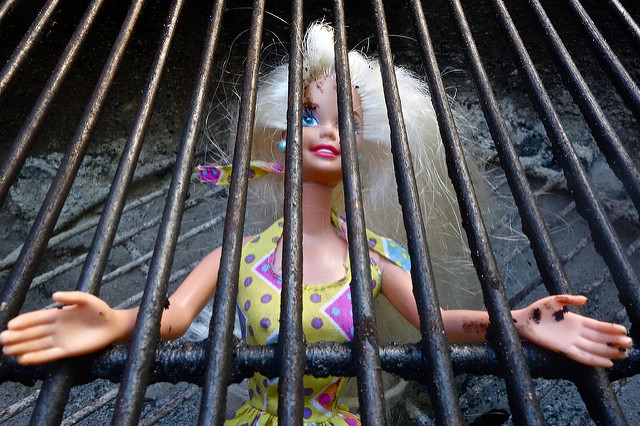
The leadership in Hamilton township, Mercer County clearly lives by their own set of rules. This is a government who deliberately destroyed government documents and did not certify the destruction of the documents in 2010. There is not one digital file available prior to July 2010 in the township. See prior story by Duffy last year on this matter.
http://www.tammyduffy.com/ARTFASHION/index.blog?entry_id=2353642
This level of negligence by the leadership in Hamilton continues. If you are a resident of Hamilton township, Mercer County, and paid your sewer or tax bill by online check or credit card, check your accounts. Residents are complaining that they were overcharged up to 5 times including additional service charges on their sewer and tax bills.
The sewer bills were significantly late to residents this year. The reason for this according to information from a township employee, was because someone was on vacation at the township. Evidently there is only one employee in the township that manages the sewer bills. This fact perplexes residents.
The sewer bills had a billing date of September 15th and were not postmarked until October 4th, already 3 days beyond the due date. Residents also see significant delays in the Federally mandated days for OPRA requests. They have 7 days to respond to an OPRA and it takes a minimum 14 days if you are lucky to get a response. Normally residents do not get responses and have to reach out to the clerk's office to see where their OPRA request is. The normal response is,"We did not get it." The residents deserve better treatment by the leadership in Hamilton.
This year in the Hamilton sewer bills there was a color promotion flyer promoting the Mayor. This flyer cost residents a minimum $1 per household. There are 90,000 residents in Hamilton. Could it be the reason the bills were late was because they were waiting for the printing of the full color mayoral ad? Residents shared their utter disgust over this on going waste by the mayor and her team.They do not treat the residents tax dollars with any level of respect.
The fact that the sewer bills were late in the first place continues to demonstrate the gross lack of management and oversight of the Hamilton township leadership.
If one goes to the online payment areas on the township website, there is no information as it pertains to site security. Any site that you use will make some effort of ensuring your data is secure. The Hamilton website does not demostrate this at all.
It is highly recommended that until the township leadership can demonstrate that they have any type of online security, residents should not use the online services to pay their sewer, property taxes of permits.
The residents who had their accounts repeatedly charged is just another example of the fraud and negligence in the Mayor's office. Even if a resident corrected this, there is no guarantee that the next quarter a payment is due this will not happen again.
In the past, residents were also hit with tax lien notices because the township leadership again was negligent in their accounting processes.
Below is the information on the township website. They have extended the due date of resident's sewer bills until Oct 25, 2016 due to the late mailing of the bills.
Sewer Payments Due – Online Payment Options Available
Second half Sewer Utility bills for 2016 will be mailed to Hamilton residents and property owners during the final week of September 2016.
Although the due date for this bill is October 1, 2016; Hamilton’s grace period to avoid interest has been extended to the close of the Township business day on Tuesday, October 25, 2016, to make this second half sewer utility payment without incurring a late fee.
After the close of the Township business day on Tuesday, October 25, 2016, any late payment for this second half sewer bill will be subject to interest charges dating back to the actual due date of October 1, 2016.
Unlike quarterly property tax payments, Hamilton residents and property owners are reminded that Sewer Utility payments are NOT automatically paid through escrow accounts (used for mortgage payments).
Remember the Online Payment Options
Several online payment options exist for residents’ and property owners’ convenience. To access these online payment options, please visit: HamiltonNJ.com/PayOnline
The typical state or local government agency spends less than 5 percent of its IT budget on cybersecurity, compared to over 10 percent in the typical commercial enterprise. If we bear in mind that some of the world’s most prominent enterprises have been successfully hacked, and that government agencies are faced with precisely the same security challenges as their commercial brethren, it is alarmingly clear that state and local agencies’ cybersecurity efforts are woefully underfunded.
Unfortunately, state and local governments have been let down by the security industry. Security has become too complex for the average agency. Mulitple products from multiple vendors don’t readily integrate and require prohibitively expensive installation and ongoing management. A typical agency doesn’t have the budget to effectively deploy and maintain all the required components.
In addition to budgetary concerns, government agencies are faced with a security staffing and know-how problem. Given the rapid growth in cyberthreats over the last few years, and the increasing corporate focus on addressing this problem, demand has created a substantial premium on cybersecurity skills. Public-sector organizations are hard-pressed to compete for talent, given the wide disparity in compensation levels. The gentleman who was in charge of economic development in the township who now retired was in also in charge of all the IT for the township. It was under his watch all the digital data prior to July 2010 was destroyed.
Local and state governments, just like the federal government, hold the information of millions of people and depend on information communication technologies and the Internet to provide a number of services to their citizens, to maintain critical infrastructure as public utilities, to share information across states and federal networks, and to make sure that first responders receive the data they need in crisis situations. This is why it is critical that states protect their cyber infrastructure and digital investments and develop comprehensive plans to increase their preparedness and resilience.
This quadruple dipping into residents accounts could be viewed as wire fraud. The government employees are fully responsible for this occurrence. As well as the mayor for overseeing the process. This could be viewed as wire fraude. The laws in NJ are clear for wire fraud.
Whether it is charged as a State offense or Federal offense, bank fraud is a serious crime and can be punishable up to 30 years in prison and/or a fine of up to $1,000.000.
The Bank Fraud Statute is 18 U.S.C. § 1344. It states:
Whoever knowingly executes, or attempts to execute, a scheme or artifice–
(1) to defraud a financial institution; or
(2) to obtain any of the moneys, funds, credits, assets, securities, or other property owned by, or under the custody or control of, a financial institution, by means of false or fraudulent pretenses, representations, or promises;shall be fined not more than $1,000,000 or imprisoned not more than 30 years, or both.
The residents of Hamilton need to be vigilant and continually check their accounts. The township does not have the appropriate online security tools to protect your data. Keep an eye on your accounts or the township will continue taking more money than they are entitled to from your personal accounts.

Beach Contamination A Hurricane Reality
Photos by Tammy Duffy Copyright 2016
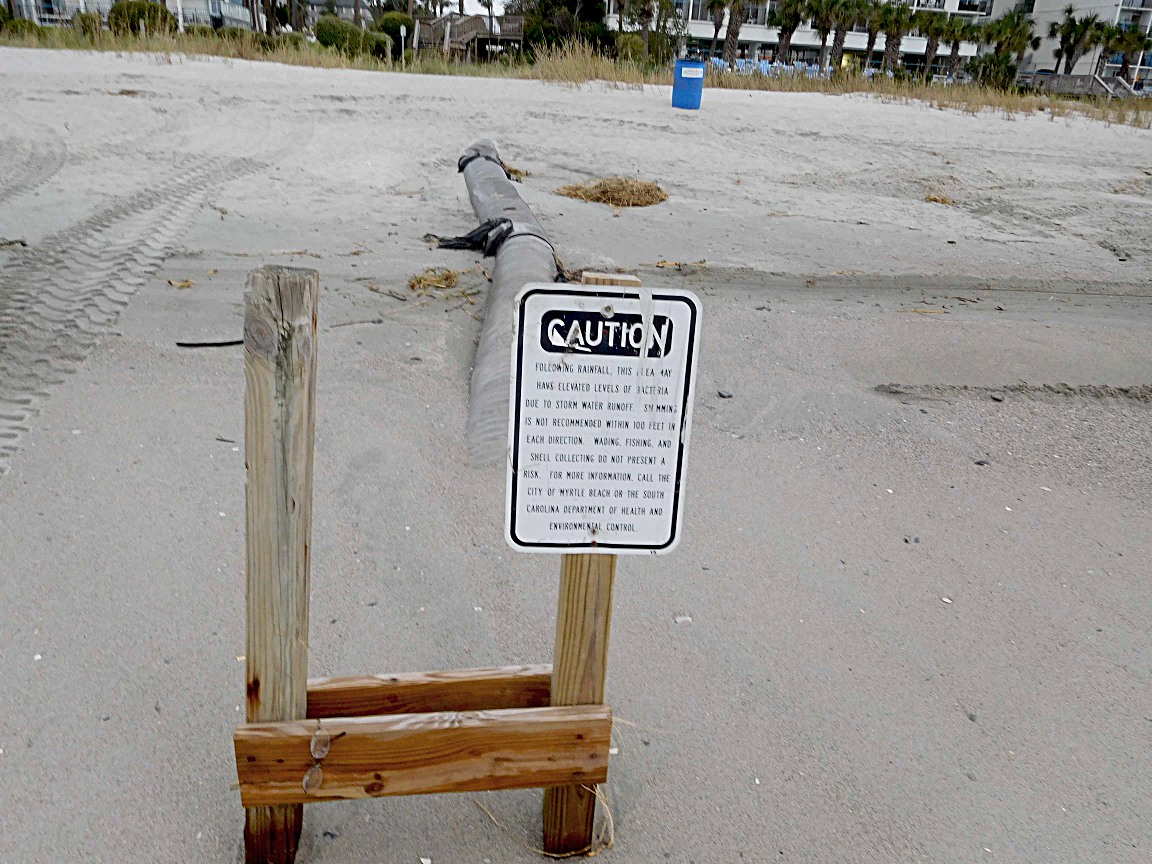


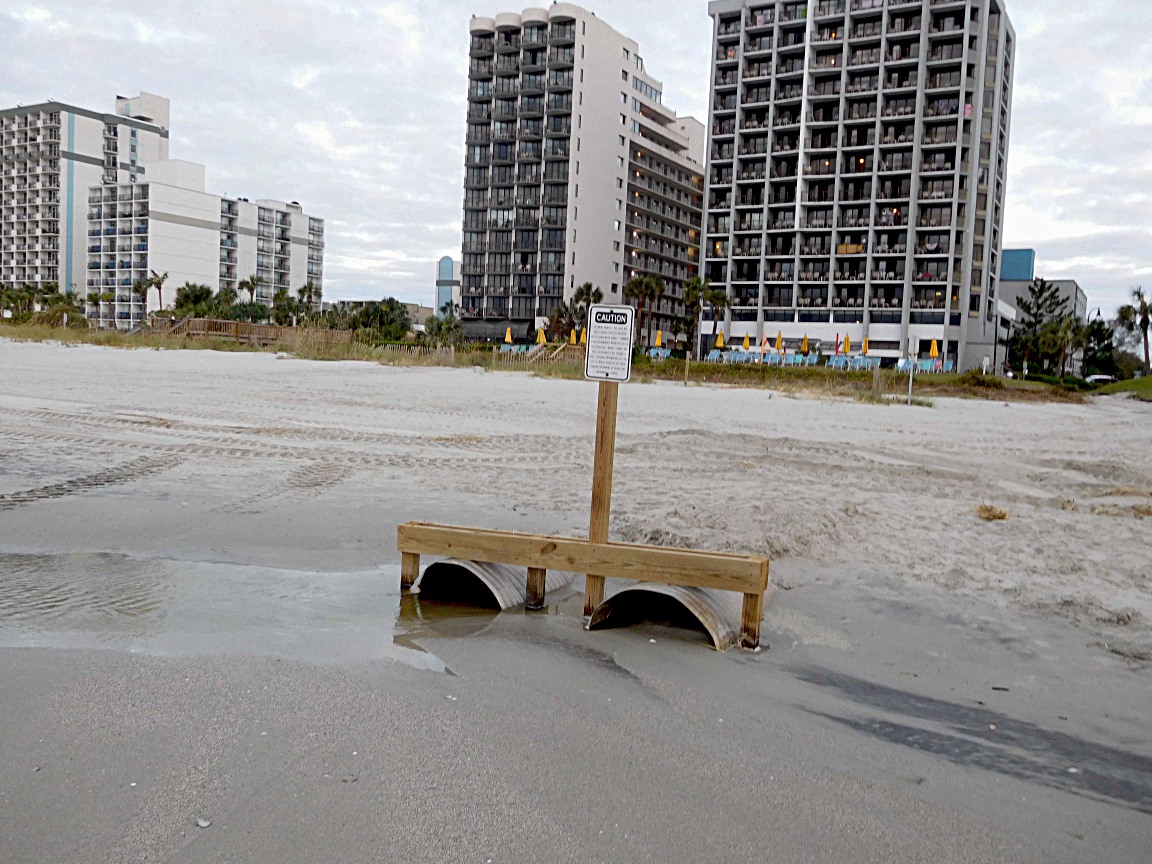
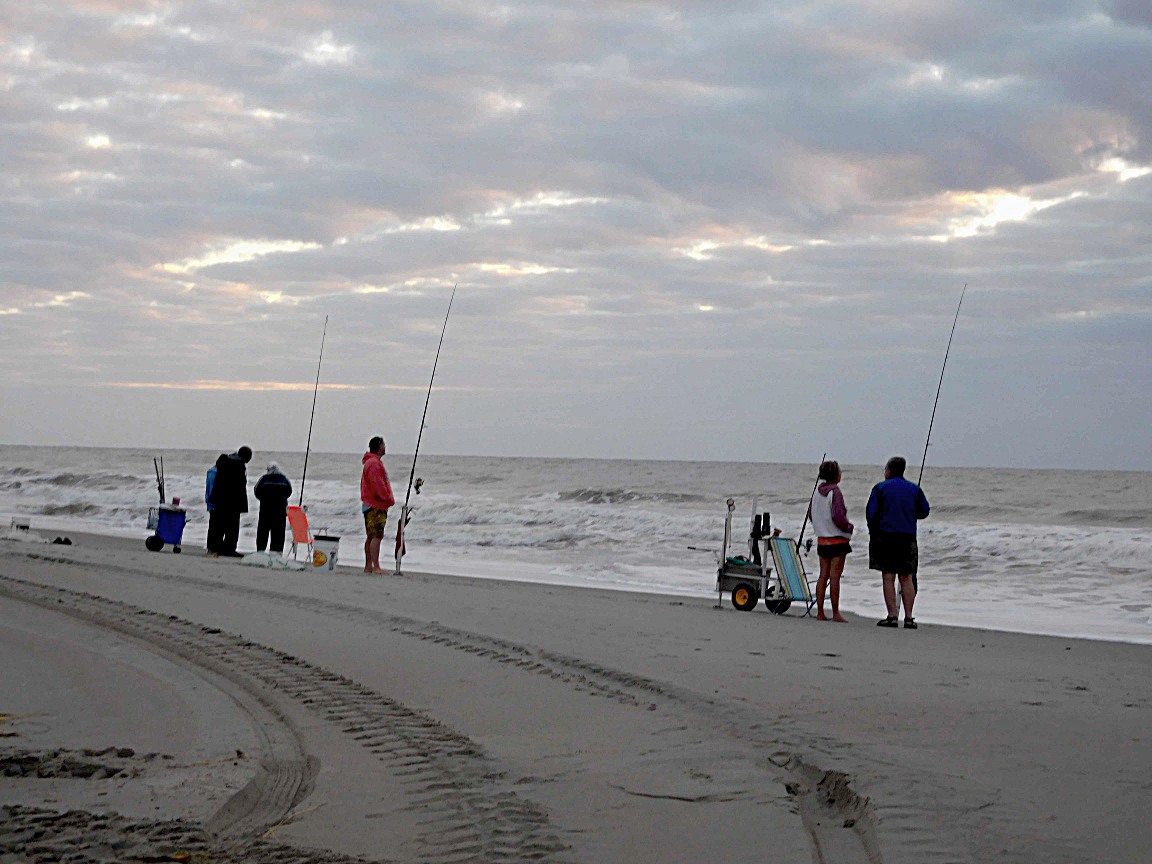
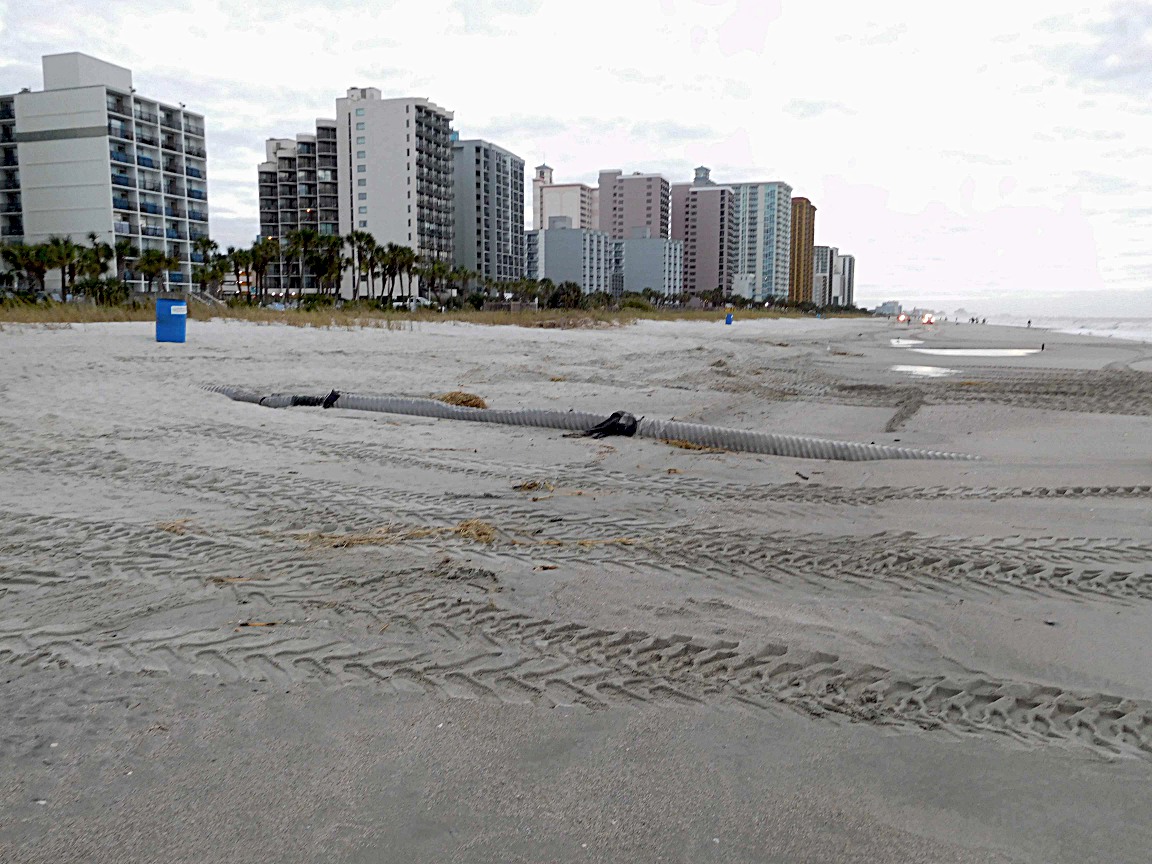
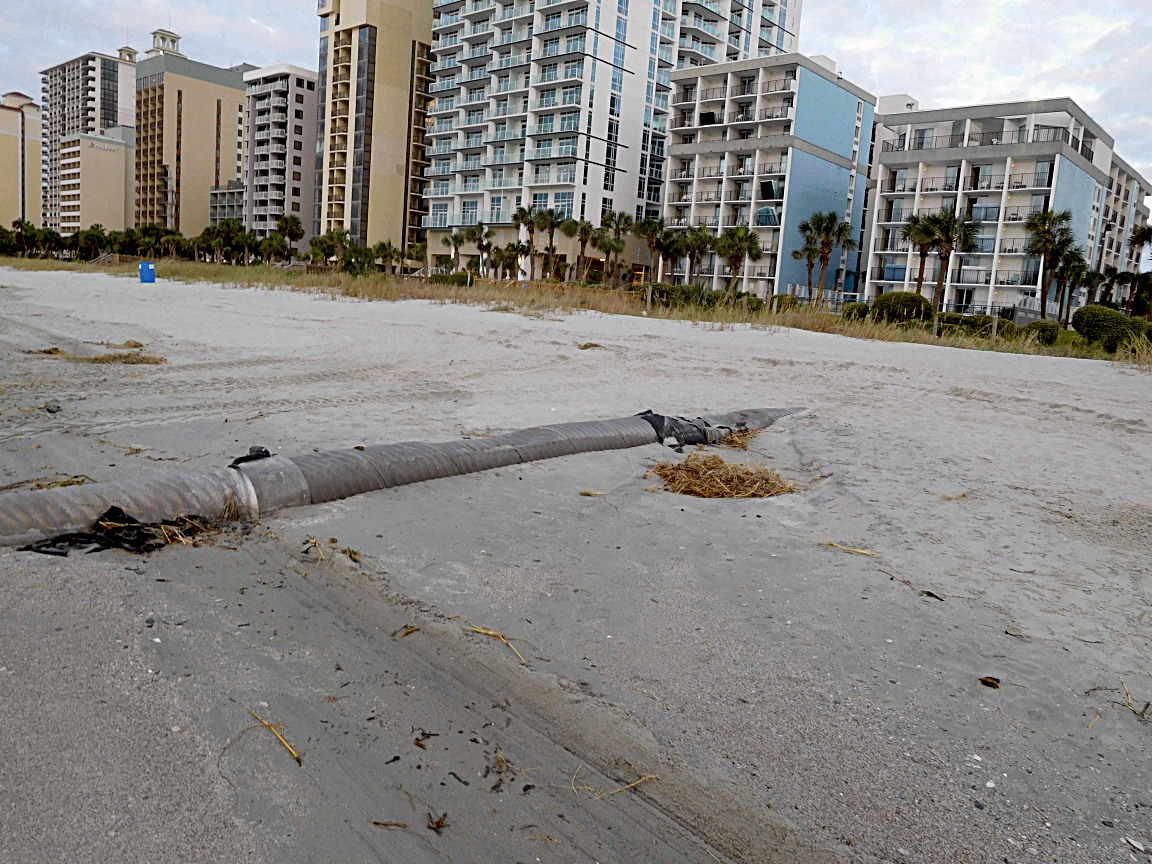
Sending the stormwater out to the deep sea has been shown to improve water quality in the swimmable surf.
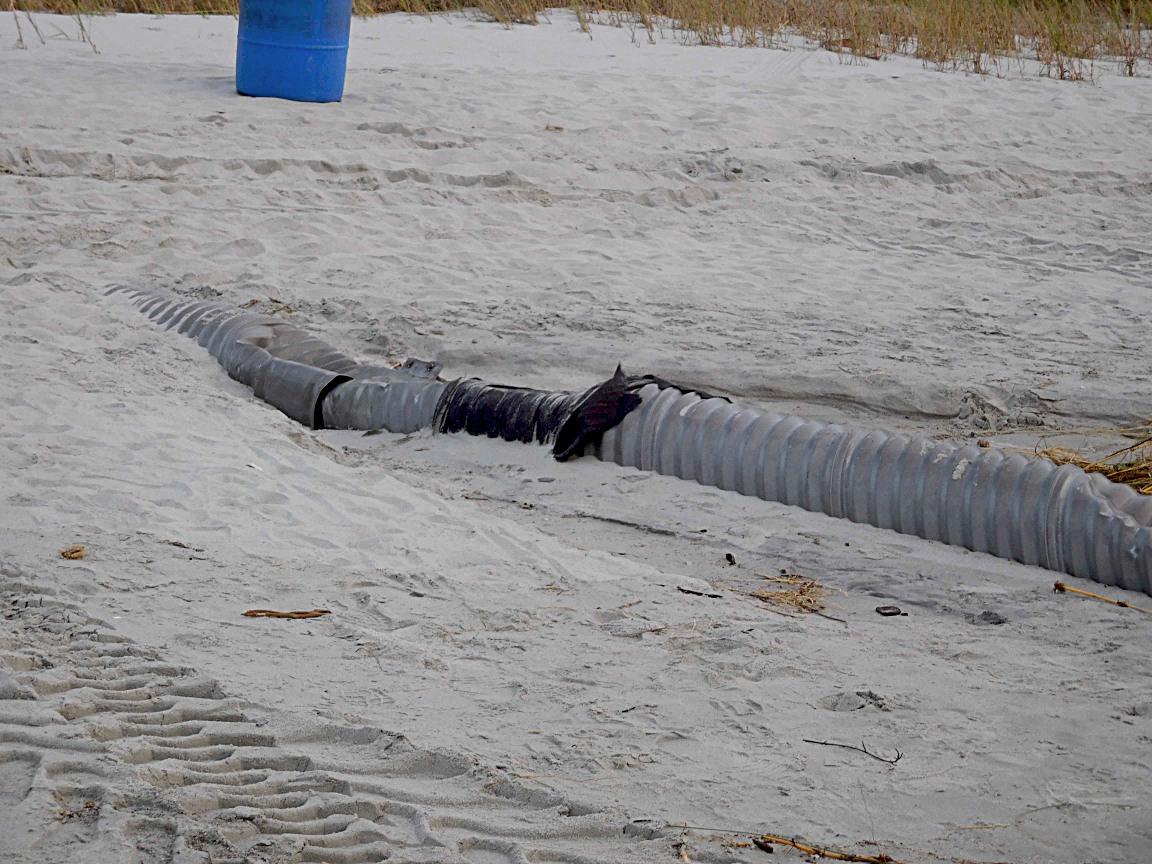
However, Hurricane Matthew destroyed the pipeline. The photos in this article taken by Tammy Duffy demonstrate the exposure and destruction of the pipeline.
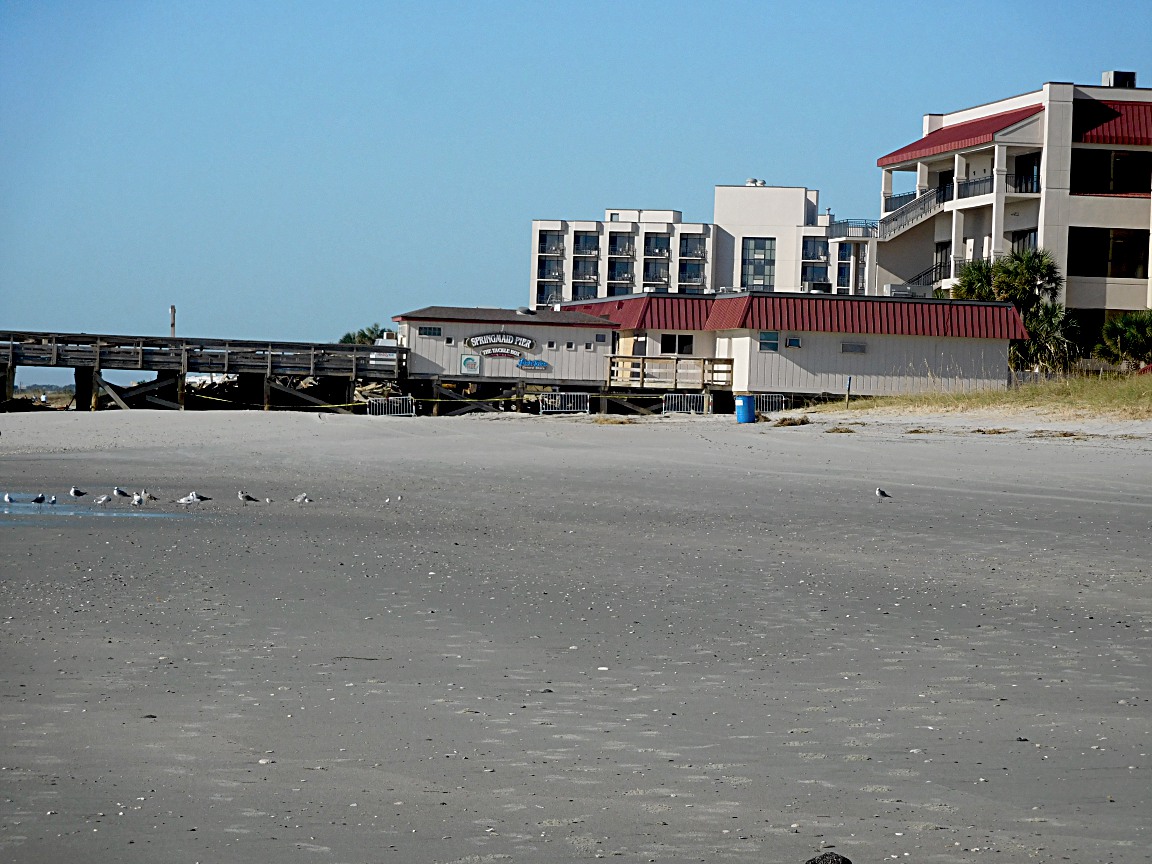
Myrtle Beach city officials said that storm surge from Hurricane Matthew destroyed the Springmaid Pier, leaving only 100 feet standing of the structure. This structure was rebuilt after Hurricane Hugo in 1989.

Family Holiday Options

Inside the Hilton hotel, Ocean 22: Photo by DUFFY
There is also a point system they use to develop your level of investment costs. For example if you think you will take 7-14 days of vacation a year you could be put into a 2,400 point option. This option costs, $14,490 today. A 3,400 point option would cost $20,590. However, these are not the only costs. There is an additional $800-$1,000 a year cost in addition for maintenance, insurance, taxes, etc. These costs are based on getting "deeded" in their Myrtle Beach property. They state that you can at any time sell this back to Hilton and you will get 100% of the costs you have invested into the membership. However, this was not clearly stated on the contract they shared with us.
The initial investment cost is not just $14,490 for 2,400 points (which allows you to pick properties kind of like you would on the airlines...use your points to go here or there for free or at a nominal additional cost for the week, several hundred dollars. There is also a HOA cost that is paid annually and runs from $800 to $1,000 for the Myrtle Beach property. Other properties could cost more. So your total investment over 20 years would be more like $14,490 + 20 years x the HOA costs =$14,490+ $16,000( HOA at a cost of $800/year for 20 Years) = $30,490. Clearly not the original $14,490 they claim. The sales person stated that you can finance the package to pay for it. They never shared the rate of the finance package. We are of the attitude, if you cannot pay cash for your vacation then you should wait until you can actually afford to take a vacation.
The property in Myrtle Beach is however quite lovely. It has been built one and a half years ago to withstand a Category 5 hurricane. Having just visited the property after Hurricane Matthew, we can attested there were no issues at the hotel. Many other properties surrounding the hotel were flooded, even on their 11th floors, due to the sealed not holding on the windows. There was a fisherman on the beach that shared that their 11th floor condo had several feet of water in it from the storm. There were also numerous properties that placed the mattresses and furniture on the decks to dry out.
TIP...You can purchase your "deed/membership" from any of the available "deed" properties within Hilton. Always look for the one with the lowest costs. When you become a member no one will ever ask you, "Where are you deeded at within Hilton?". They just ask for your membership number, so why get deeded in NYC or Hawaii where the annual taxes, homeowners, etc will be higher than on Orlando or Myrtle Beach. Orlando we were told has the lowest costs.
Although you won’t be eligible for any discounts as a member of Hilton Grand Vacations Club, you receive silver membership status in Hilton’s HHonors, which means you can earn a different set of points you can use at Hilton hotels and resorts. However, you can ask the concierge during your stay about local discounts, and they may have coupons for restaurants, show tickets or other activities and rentals, but this varies by location.
Hilton has a highly recognizable name in the hotel and resort industry, so you are likely to find a resort in a location in the network that you want to visit. Even if you don’t, you have the option of trading through an exchange group. Although Hilton Grand Vacation Club doesn’t rank as the best timeshare company on our list, it would be an excellent choice if you want to stick to a trusted hotelier as your vacation club.
I highly recommend staying at the Myrtle Beach property, Ocean 22, on your own before it gets completely sold out. It's a lovely property with great views, lovely pool, gym and other amenities. The salesperson told me I had one of the worst rooms in the building. Yet, it was lovely. I never got to see any of other other rooms during the 3 hour hostage presentation but would stay in my room again in a heartbeat.There are many great thing to do nearby besides golf that many can enjoy.
See photo link below from our recent trip to the area: Photos by Tammy Duffy Copyright 2016
https://www.facebook.com/Duffyculturalcourture/photos/?tab=album&album_id=670022319827008

Hunterdon Art Museum Hosts Halloween Dance Party Fundraiser
Get your scare on at the Hunterdon Art Museum Saturday, October 29 when it hosts a “Ghouls! Goblins! Gremlins! Halloween Dance Party.”
The party kicks off at 8 p.m. and features food from 15 Landsdowne Catering and a wild array of fabulous beverages supplied by Hunterdon Brewing Co. and featuring River Horse Brewing Co., Sixpoint Brewery and Ironbound Hard Cider. There will also be an assortment of wines and several “Monster Cocktails.”
Come in costume for a chance to win a hideously horrifying costume contest, or become a whirling dervish with devilish dancing music by DJ Treatz capped with a “Thriller” mix dance contest.
The evening will also offer more raffles than you can shake a witch’s wand at. Proceeds benefit the nonprofit Museum’s education program and exhibitions of contemporary art, craft and design.
Tickets are $45 in advance or $55 at the door, and guests will receive one ticket for one free beer or glass of wine. A cash bar is also available. You can order your tickets online at www.hunterdonartmuseum.org or by calling us at 908-735-8415.
This is a 21 and older event.
HAM’s Halloween Dance Party lead sponsor is 15 Landsdowne Catering. This event is also being sponsored by Unity Bank, ShopRite of Hunterdon County, Starr’s Party and Tent Rentals, Hunterdon Brewing Co. Metropolitan Seafood. Co. Beer sponsored by featuring River Horse Brewing Co., Sixpoint Brewery and Ironbound Hard Cider.
GENERAL INFORMATION FOR THE PUBLIC
The Museum is at 7 Lower Center St. in Clinton, New Jersey, 08809. Our website is www.hunterdonartmuseum.org and our telephone number is 908-735-8415. Hours are Tuesday through Sunday, 11 am – 5 pm and suggested admission is $5.
ABOUT THE HUNTERDON ART MUSEUM
The Hunterdon Art Museum presents changing exhibitions of contemporary art, craft and design in a 19th century stone mill that is on the National Register of Historic Places. Founded in 1952, the Museum is a landmark regional art center showcasing works by established and emerging contemporary artists. It also offers a dynamic schedule of art classes and workshops for children and adults.
Programs are made possible in part by funds from the New Jersey State Council on the Arts, and by funds from the Geraldine R. Dodge Foundation, New Jersey Cultural Trust, Hunterdon County Cultural & Heritage Commission, The Wolf Kahn and Emily Mason Foundation, Investors Bank, The Large Foundation, The Bunbury Company, and corporations, foundations, and individuals. The Hunterdon Art Museum is a wheelchair accessible space. Publications are available in large print. Patrons who are deaf, hard of hearing or speech impaired may contact the Museum through the New Jersey Relay Service at (TTY) 1 (800) 852-7899

Hunterdon Art Museum Hosts Halloween
Dance Party Fundraiser
Get your scare on at the Hunterdon Art Museum Saturday, October 29 when it hosts a “Ghouls! Goblins! Gremlins! Halloween Dance Party.”
The party kicks off at 8 p.m. and features food from 15 Landsdowne Catering and a wild array of fabulous beverages supplied by Hunterdon Brewing Co. and featuring River Horse Brewing Co., Sixpoint Brewery and Ironbound Hard Cider. There will also be an assortment of wines and several “Monster Cocktails.”
Come in costume for a chance to win a hideously horrifying costume contest, or become a whirling dervish with devilish dancing music by DJ Treatz capped with a “Thriller” mix dance contest. The evening will also offer more raffles than you can shake a witch’s wand at.
Proceeds benefit the nonprofit Museum’s education program and exhibitions of contemporary art, craft and design.
Tickets are $45 in advance or $55 at the door, and guests will receive one ticket for one free beer or glass of wine. A cash bar is also available. You can order your tickets online at www.hunterdonartmuseum.org or by calling us at 908-735-8415.
This is a 21 and older event.
HAM’s Halloween Dance Party lead sponsor is 15 Landsdowne Catering. This event is also being sponsored by Unity Bank, ShopRite of Hunterdon County, Starr’s Party and Tent Rentals, Hunterdon Brewing Co. Metropolitan Seafood. Co. Beer sponsored by featuring River Horse Brewing Co., Sixpoint Brewery and Ironbound Hard Cider.
GENERAL INFORMATION FOR THE PUBLIC
The Museum is at 7 Lower Center St. in Clinton, New Jersey, 08809. Our website is www.hunterdonartmuseum.org and our telephone number is 908-735-8415. Hours are Tuesday through Sunday, 11 am – 5 pm and suggested admission is $5.
ABOUT THE HUNTERDON ART MUSEUM
The Hunterdon Art Museum presents changing exhibitions of contemporary art, craft and design in a 19th century stone mill that is on the National Register of Historic Places. Founded in 1952, the Museum is a landmark regional art center showcasing works by established and emerging contemporary artists. It also offers a dynamic schedule of art classes and workshops for children and adults.
Programs are made possible in part by funds from the New Jersey State Council on the Arts, and by funds from the Geraldine R. Dodge Foundation, New Jersey Cultural Trust, Hunterdon County Cultural & Heritage Commission, The Wolf Kahn and Emily Mason Foundation, Investors Bank, The Large Foundation, The Bunbury Company, and corporations, foundations, and individuals. The Hunterdon Art Museum is a wheelchair accessible space. Publications are available in large print. Patrons who are deaf, hard of hearing or speech impaired may contact the Museum through the New Jersey Relay Service at (TTY) 1 (800) 852-7899

Blurred Lines between Past and Present: Zimmerli Examines Artwork Created Circa 1966,
Themes Remain Relevant Half a Century Later
When the Zimmerli’s curators first devised two complementary exhibitions of American art titled Circa 1966 – one focusing on prints, the other on paintings and sculpture – the intention was to commemorate the museum’s golden anniversary by spotlighting key works created around the time of its founding. But in addition to spotlighting revolutionary movements that now have an established presence in art history, the subjects of many of the works focus on social and political discussions from the era that have prominently re-emerged across the United States. Both American Prints from the Collection and Paintings and Sculpture from the Collection, on view through January 2017, invite visitors to gain insight into the present by examining the past through the eyes of artists whose works are as relevant now as they were at the time of their genesis.
In 1966, Rutgers established the University Art Gallery – occupying a modest two-room space in Voorhees Library – as part of a major effort to integrate and promote arts at the university. It was a visionary move: only an hour from campus, New York City was the established center of the global art world after World War II and attracted artists who formed influential communities and led movements that have had lasting impact. Since then, the institution – renamed the Jane Voorhees Zimmerli Art Museum after a major expansion in 1983 – has developed in size and scope to become one of the most prominent university art museums in the nation. In addition, the Zimmerli continues to develop an impressive collection of mid-century American art.
“The era generated renewed interest in printmaking in the United States: artists and printers collaboratively experimented with both traditional and innovative techniques, which invigorated the field,” notes Christine Giviskos, the museum’s Curator of Prints, Drawings, and European Art. “As far as subject matter, many of these printmakers were influenced by social upheavals that occurred during the late 1960s and early 1970s, focusing on widespread concerns not unfamiliar today: ongoing wars abroad, contentious political contests, and violence against protestors standing up for civil and equal rights.”
The year 1968 was especially turbulent, with artists documenting historical events that resonate with today’s audiences as the 2016 election season gains momentum. Robert Rauschenberg incorporated imagery directly from newspapers and magazines to create Guardian that year. Viewers can sense the political chaos and social unrest through his multi-layered images that compound the experiences of everyday life. The New Jersey Volunteers for McCarthy took a more active role in the American democratic process. The group recruited 14 artists – all living or working in the state – to contribute to a portfolio that was sold to raise funds to support the campaign of Eugene McCarthy (against incumbent Lyndon B. Johnson) during the 1968 Democratic primaries. Lithographs by James Kearns, Jacob Landau, and Pat Pickering chronicle the discontent of the era and Senator McCarthy’s efforts to disrupt the political establishment.
Two iconic portraits reflect the impact that both well-known and anonymous figures, as well as the contributions of artists, had during the 1960s Civil Rights Movement. Two years after the 1963 March on Washington, Ben Shahn’s ink portrait of Martin Luther King, Jr., delivering his “I Have a Dream” speech, was on the cover of Time Magazine. In 1968, Stefan Martin translated that recognized image into a wood engraving that was published in two editions, with proceeds from the sale benefitting the Southern Christian Leadership Conference, which Dr. King had helped establish. Calvin Burnett, an African American artist born and raised in the Boston area, also contributed his talent to raise funds and awareness. His 1969 lithograph Freedom Fighter, portraying a young African American, was published to generate support for private funding for Operation Exodus, a school busing program in Boston. While the city’s public schools were desegregated to comply with the law, public funds to transport students from their largely segregated neighborhoods were not provided. However, through Operation Exodus, more than 2,000 African American children were able to travel out of their home districts and obtain a better education.
Reflecting the changing trends in transportation, two prints address the conflicted feelings many Americans have regarding car travel: freedom versus frustration. Richard Fiscus’s screenprint Route 1, No.1 (1969) depicts the open road of the iconic Pacific Coast Highway (Route 1) in Northern California. The influence of Pop art is present in the bold colors and simplified forms of this landscape view along the ocean, implying a laid back attitude often associated with the west coast. The three-dimensional lithograph AARRRRRRHH (1971), from the portfolio No Gas, by Red Grooms represents the other side of driving: being stuck in traffic. While the amusing title pokes fun at the chaos of New York City’s streets, the scene is now an all too familiar experience for many commuters. (Grooms also plays a role in the Zimmerli’s history. In 1973, the Rutgers University Art Gallery hosted the blockbuster exhibition The Ruckus World of Red Grooms, which was the artist’s earliest retrospective.)
“The wide range of art produced and collected in the years around 1966 also indicates the global energies of the art market and the efforts of artists to explore new materials, techniques, and ideas, pushing audiences toward new experiences,” adds Donna Gustafson, Curator of American Art and Mellon Director for Academic Programs. With the assistance of Mellon 2016 Summer Interns Kaitlin Booher and Todd Caissie, Gustafson organized Circa 1966: Paintings and Sculpture from the Collection. “Artists from around the world came to New York City not only to study with contemporary masters of these movements, but also to explore their own innovations.”
Marion Greenstone and Ray Parker were among the American artists influenced by broader cultural themes. Greenstone, a native New Yorker, combined oil and acrylic paints with newsprint and paper collage to create 1964’s Spoonk, which meanders across six canvases. This assemblage captures the spirit of the decade’s consumer culture, combining disembodied images of women with advertisements for food, cars, and sports. But she also prominently placed a white rabbit, suggesting a reference to the era’s influential counterculture. Originally from South Dakota, Parker was a trumpet player who incorporated his love of jazz improvisation into his practice. After moving to the city in 1951, he joined the circle of artists around the abstract expressionists, becoming close to Mark Rothko and Willem de Kooning. But his work ultimately resulted in a refined format of intense colored forms floating on a pale surface, as seen in his untitled painting from 1965 featured in the exhibition. It secured Parker’s reputation as an artist who had moved beyond abstract expressionism.
Established artists from around the world also arrived in New York City to take their careers in new directions. Friedel Dzubas had studied with Paul Klee in Berlin before escaping Nazi Germany in 1939. Though friends with abstract expressionists Jackson Pollack and Willem de Kooning, he also experimented with what we now term color field painting. Following the revolutionary practice of his studio-mate Helen Frankenthaler, Dzubas soaked diluted acrylic paint directly into unprimed canvas. His mastery of color and textural effects is apparent in his 1966 painting Deep Noon, which – expanding the length of a gallery wall – evokes a muted, southwestern landscape. Born and raised in Kyoto, Japan, Shingo Kusuda came to the United States in 1964 as part of the Japanese American Cultural Research program sponsored by the American collector and publishing executive John Powers. Along with three other artists from Kyoto, he spent six months working with contemporary American artists. Kusuda also developed an appreciation of unconventional materials; his mixed media Work #19 (one of four works by the artist in the Zimmerli’s collection) incorporates cement, wood, and collage, demonstrating his contributions during this dynamic era of exploring surface effects in painting.
Circa 1966: American Prints from the Collection was organized by Christina Weyl, Ph.D. (Rutgers 2015), with assistance from Nicole Simpson, Assistant Curator of Prints and Drawings, and is on view September 3, 2016, to January 29, 2017. Donna Gustafson, Curator of American Art and Mellon Director for Academic Programs, with the assistance of Mellon 2016 Summer Interns Kaitlin Booher and Todd Caissie, organized Circa 1966: Paintings and Sculpture from the Collection, which is on view September 3, 2016, to January 8, 2017.

Kelsey Review, the literary journal that has been published annually by Mercer County Community College (MCCC) for 35 years, still features contributors who live, work and/or study in Mercer County. But the publication has adopted a new format and, starting with its recently released Fall 2016 issue, will be posted as a quarterly online publication. Additional issues will be released in December, March, and June.
Kelsey Review’s Fall 2016 issue features fiction by Ed Carmien, Mark Galarrita, Annabelle Kim and Daniel Picker; poetry by Lois Marie Harrod, Donald Lasko, Carolina Morales, and Patrick Walsh; nonfiction by Luz Horta and Dorothy Kohrherr; and photography by Jessie Liang.
Says Kelsey Review Editor Jacky Vogtman, MCCC Assistant Professor of English, “Our Fall issue, like the season itself, is full of color, of darkness and light, of the past colliding with the present and transforming into the future.” Several contributors have been featured multiple times over the years, while others are new to the fold. Links to the current and past issues of Kelsey Review can be found at www.mccc.edu/kelseyreview.
Vogtman says she is gratified to be at the helm of the publication as it transitions into a quarterly online journal. “The Review has a long history at MCCC and in the community. It is exciting to be a part of the journal's metamorphosis into something that continues the tradition of bringing together the talented voices of our region while also embracing the changes that are taking place in the literary landscape.”
The editorial board also includes fiction editor Roberta Clipper, Professor of English at Rider University; poetry editor Luray Gross, a poet and storyteller who works as an Artist in Residence in New Jersey and Pennsylvania; and poetry editor Ellen Jacko, a retired English teacher from Allentown High School.
Kelsey Review welcomes new friends on its Facebook page. The editors invite the community to “like” the page and add their comments about the material in the journal and the arts in general.
Submissions for all quarterly issues are accepted online between January 1 and May 31 in the following categories: fiction, non-fiction, poetry, art, photography and reviews. For more information, email Kelsey.review@mccc.edu or visit www.mccc.edu/kelseyreview.
Funding for Kelsey Review has been made possible in part by the Mercer County Cultural and Heritage Commission through funding from the Mercer County Board of Chosen Freeholders, and the New Jersey State Council for the Arts/Department of State, a partner agency of the National Endowment of the Arts.

MaJOR CONFLICT with Hamilton Township Electricity Meeting September 29th
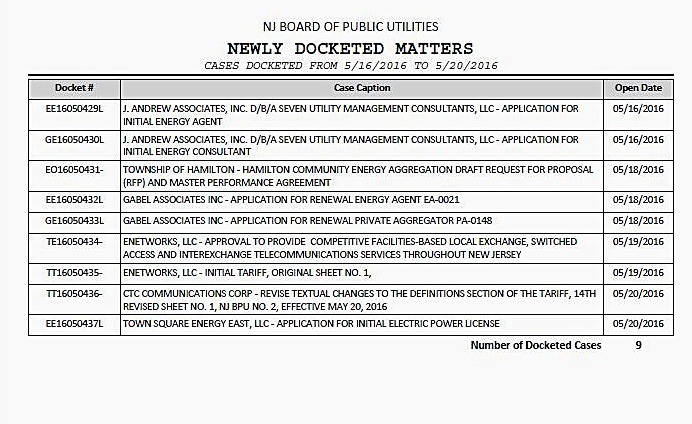
Two months after Hamilton Council killed a resolution that would have reduced homeowner electricity bills, the Mayor of Hamilton has announced the township will host a public information session next week to educate the public about the potential benefits of being enrolled into a third-party energy aggregation program.
The public information session on Energy will be held 6:30 p.m. Sept. 29 at the lower-level meeting room of the Hamilton Free Public Library.
She states she wants the residents to fully understand how this program works, so they can be comfortable in participating and will enjoy the savings that the bulk-purchasing of electricity can provide.
Yet, she deliberately scheduled this meeting so the vast majority of Hamilton residents cannot attend. This is being held the same night of the well in advance previously announced Hamilton School District Back to School Night.
Why would the Township schedule this important event that conflicts with a School District-wide parent student event? This will clearly impact the attendance at one of the events and it is doubtful that is will be the back-to-school night. This was done on purpose. Why? They need to immediately reschedule this event to ensure the entire community is made aware and can attend.
The mayor states the reason she is proposing this initiative for the community is so residents can reduce electricity costs.
The public information session will be held 6:30 p.m. Sept. 29 at the lower-level meeting room of the Hamilton Free Public Library.
During the public information session, Hamilton’s energy aggregation consultant, Gabel Associates, will give a formal presentation explaining the program. Attendees will then be encouraged to engage in an interactive question-and-answer period.
On July 19, Hamilton Council heard negative feedback from residents and then voted 3-2 to reject a resolution that would have automatically entered homeowners into a third-party program that would have reduced their electric bills by 7 percent for at least nine months.
Unfortunately, the state of NJ has no laws against cramming. The leadership of Hamilton is taking advantage of this. Cramming involves unexpected or unauthorized charges on a bill for power. Cramming also allows government entities to change your power without your permission.
The public information session on Engery will be held 6:30 p.m. Sept. 29 at the lower-level meeting room of the Hamilton Free Public Library.
For all the countless types of goods and services consumers can buy, they basically fall into one of two different payment categories: those where you know (or can find out) your total cost before you agree to buy it, and those where you can't know the full cost until after you've taken on responsibility to pay for it. During a Hamilton school board meeting in 2015, it was stated by one of the school board members," We did not understand the lease we had and the balloon payment we had at the end, we were not prepared for." This "surprise" (aka. leaders without a clue) cost the township millions of dollars. The likelihood that the leadership understands this power proposal is highly unlikely.
The leadership in the township has not demonstrated that they have the ability to understand any program they initiate. Residents saw this with the reassessments that recently occurred with their properties. On the township page right now, they are sending residents directly to Gabel Associates with their questions, not to anyone in the township. This is another cluster in the making with this Energy plan, no doubt.
Electricity is another bill-after-the-fact service: first you use the power and then you're charged for it, and if the bill proves higher than you can afford, there's no option to return or give back the extra wattage (though you can definitely take steps to reduce your power usage henceforth).
Even determining the price-per-kilowatt hour in advance doesn't always work. This is partly because the energy market is always in flux, largely due to reasons beyond sellers' or buyers' control: anything from cold winters to hot summers to political instability in any of a hundred different energy-producing regions can lead to a price rise. In documents on the township website it states they are going to purchase a "bulk of power" upfront to ensure a "cheap rate".
But customers of third-party energy providers (as opposed to the single regulated utility in a given area) frequently complain of enormous price rises far higher than normal energy-market economics would indicate.
A sampling of reader complaints we'd collected about a 3rd party Energy company, the majority of which boiled down to, “They promised low rates but then my bills skyrocketed, and canceling the contract proved difficult and expensive, too.”
Electric deregulation fails to live up to promises as bills soar. Deregulated energy consumers often end up paying far higher rates than do customers of the local regulated utility. T
There are five big red flags in the electric market: exorbitantly high rates; low introductory or “teaser” rates that suddenly disappear; unexpected extra fees; punishing exit fees; and high-pressure sales tactics.
Third-party electric customers in Connecticut have long reported similar problems to their utility boards, to the point where the state House of Representatives unanimously passed a bill that would set certain limits on third-party residential energy providers.
Right now, it’s a buyer-beware electric market. States are getting complaints from power shoppers who thought they were signing up for one deal but then got slammed with some of the highest electric rates we’ve ever seen from alternative suppliers. What is the cost per KWH that Hamilton's leadership is proposing? What is the Bulk rate price they are signing up to? Is that based on a certain amount of power used? What is someone uses more power, less power, new homes get built and add to the power consumption, etc.
Consumers have reported paying even higher prices from these changes in the state. From January through April, some have seen a 115 percent increase in complaints and inquiries about alternative electricity suppliers over the same period a year ago. These contacts ranged from simple questions about electric offers to something more serious:
Extra Fees: Ask if there is a monthly fee, and factor that into the per kWh price. Many suppliers charge exit fees of up to $175 if a customer leaves a plan before the contract is up. Under the law, customers are allowed to leave a contract without paying an exit fee within 10 days after the date of the first bill from a supplier.
Below is a link to an independent company reviewing ConEd
http://callmepower.com/suppliers/conedison-solutions/reviews#fixed-rates
Gabel Associates has helped 12 other towns across New Jersey enter into third-party energy programs, including Toms River, which has a population slightly larger than Hamilton’s with about 90,000 residents. Homeowners enrolled into third-party programs in the municipalities of Plumsted, Monroe, Montgomery, West Orange, Lambertville, West Amwell, Colts Neck, Raritan, Flemington, Eatontown, Old Bridge and Toms River have realized energy cost savings ranging from 8.5 percent to 19 percent in the supply portion of their energy bills, according to the press release issued by Yaede’s office.
Hamilton Councilmen Dennis Pone and Dave Kenny supported the energy cost-savings resolution at the July 19 council meeting, but the measure failed to pass when Council President Ileana Schirmer and Councilmen Ed Gore and Ralph Mastrangelo voted it down.
Pone suggested it was his duty as an elected official to vote in favor of the 14-month, third-party energy program that would have retained identical power and identical service but would have resulted in at least nine months of reduced energy bills for his constituents over the 14-month contract period. “If I could save people $78 a year, I’d think I was elected to tell them what to do,” Pone said at the meeting. He also said, “I have never as a councilman never made a decision where saving money is guaranteed and I am not going to vote for it.”
Mastrangelo suggested $78 in estimated annual savings was insignificant; Schirmer said government should not tell homeowners what to do and should not automatically enter people into a program without a homeowner’s prior consent; and Gore said he did not like how the energy cost-savings resolution was added to the council’s July 19 agenda at the last minute. Again, to limit the residents on hearing about the program. It was not on the published agenda prior to the meeting on July 19th. There is a resident on video who attended the meeting on July 19th, with the printed agenda from the townships website, stating, "Why is this not on the agenda?"
How much money has been spend paying Gabel Associates to do this analysis? What did that cost taxpayers? What will it cost to initiate this type of program? Residents bet its higher than the $78 dollars in savings by changing.
If council had passed the resolution, all of Hamilton’s residential homeowners — the ones who do not have solar panels installed on their properties — would have been automatically enrolled into a program by third-party power supplier ConEdison Solutions that would have reduced homeowner electric bills by 7 percent for at least nine out of 14 months from October 2016 through December 2017. If residents do not see a 7% decrease they will have the right to sue the township due to all the collateral they have launched that guarantee at minimum a 7% decrease. This will also cost residents more than the promised $78 savings per year.
Residential customers who are automatically included (See Below on who is automatically included) in the program have the right to “opt-out.”
However, it is advantageous for all residents to join and remain in the program, as this gives the community the “strength in numbers” to negotiate the best price for consumers. All residents will receive information about the program and be given the opportunity to opt-out.
Customers that have their own, independent TPS contracts, or that have a solar power system installed on their property are not included initially but are given the option to join the HCEA program.
The program rules, which have been established by the State of New Jersey, have been set up this way to ensure that a sufficient number of households will participate to obtain a meaningful bid, and to avoid the costly and time-consuming process of having everyone affirmatively sign up for the program.
The aggregation rules incorporate consumer protections, and recognize the logistical challenges of a residential procurement program, while at the same time providing a structure that will attract bidders.
When the retail choice program was originally enacted in NJ in 1999, the rules required that government aggregators be required to obtain a so-called “wet signature” from each residential customer demonstrating the customer’s affirmative consent to join. After a number of years, it was recognized that this “opt in” approach put such a burden on the programs that none got off the ground, and the model was changed by the State to “opt-out” for residential customers. Unlike business customers, residential customers represent large numbers and (relatively) small usage/margins for each account. In order for an aggregation of residential customers to work, it is necessary to get large volumes with as low transaction costs as possible. This results in the opt-out approach, which gives suppliers a firmer basis for the load they are bidding on, but still provides residential customers with the ability to opt out.
The State regulations also require that an aggregation program show savings versus the utility-provided rates. Each residential customer will receive a written notification after the bid, informing them of the price, the comparison to the utility price, and their right to opt out. As such, each resident will be fully apprised of all pertinent information necessary to make an informed decision.
In 2013, Plumsted Township, known for its farms, horse ranches and sprawling military base, is now also a trailblazer in the energy market. The Ocean County community of 8,400 became the first municipality in New Jersey to contract its electric power supply with a third-party provider, switching from Jersey Central Power & Light to Con Edison Solutions.
The subtle but significant change means Plumsted residents have been saving a few extra dollars on their electric bills each month, at no cost to the township, said Mayor Dave Leutwyler. Falling energy prices enabled Plumsted to take advantage of a decade-old state law allowing municipalities to handle bulk purchases of power supply for their customers.
Much has remained the same about a homeowner’s monthly bill, which is still sent from JCP&L, the state’s second largest electric company. JCP&L still delivers the power, maintains the infrastructure and responds to outages and emergencies. Residents are not seeing a significant savings, so why bother? LEt residents make their own choices. To have the Hamilton leadership dictate what is to be done, has neverworked in the best interest of the residents.
The only difference in the bill that residnets will see,is the section labeled Supply Charge, which will fall under "Con Edison Solutions," and appears as a separate bill for kilowatt hours used.
Con Ed can charge less because it isn’t bound by the same regulations New Jersey imposes on its four utilities, including JCP&L.
Plumsted’s move affects only the township’s residential electric customers, who was slated to save about 15 percent compared to JCP&L’s supply charges. That works out to an average savings of about $165 a year per customer, Leutwyler said. Why are other townships seeing a higher savings than what Hamilton is proposing?
A dramatic drop in energy prices — caused in part by increased natural gas supply — created an opening for unregulated third-party suppliers, said Stefanie Brand, director of the New Jersey Division of Rate Counsel. Those suppliers purchase energy on more volatile short-term markets, which have fallen faster than the longer-term guarantees that constrain utilities like JCP&L.
"That made it look good to municipalities," said Brand, the state’s utility watchdog. Rate Counsel supports the switch as long as ratepayers save money, she said. "We look at whether consumer protections are in place, make sure there are no hidden costs and that rates don’t go up during the course of the contract."
Individual residents can also seek third-party providers, but the discount will generally be much lower. Switching to a third-party provider remains a complicated process, one that took Plumsted, which has just 2,500 homes, several months to complete. A public hearing was held and plans were submitted to the state Board of Public Utilities and Rate Counsel for review. Any of New Jersey’s 110 licensed third-party suppliers were then allowed to bid on the contract and in October, the township council approved the measure.